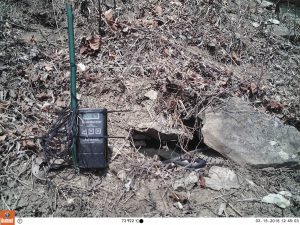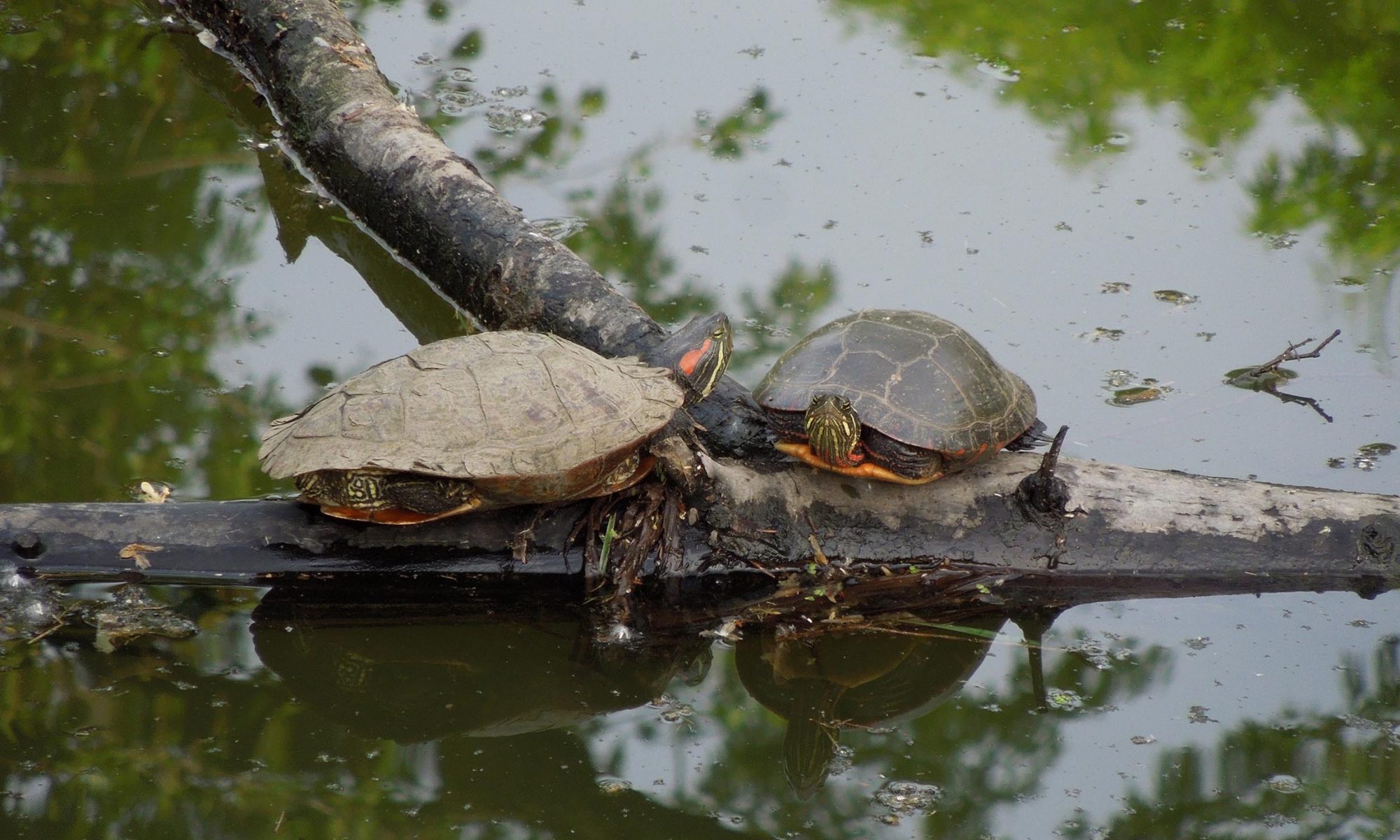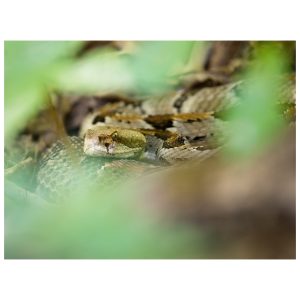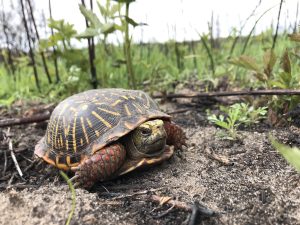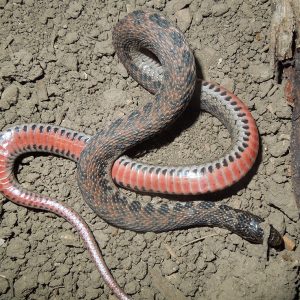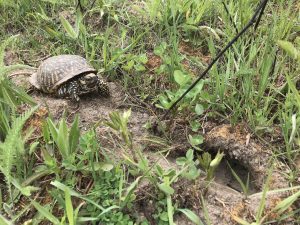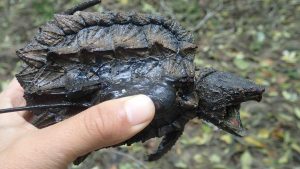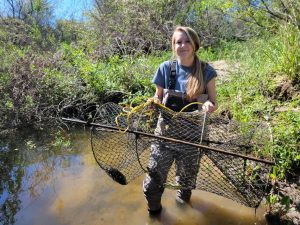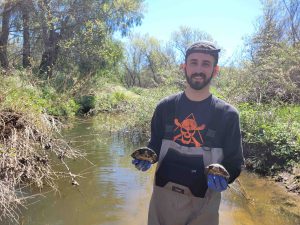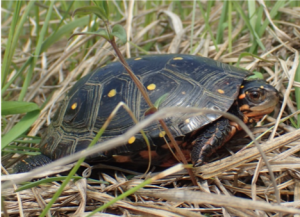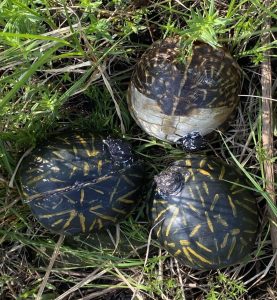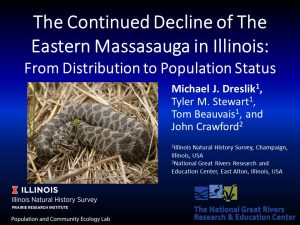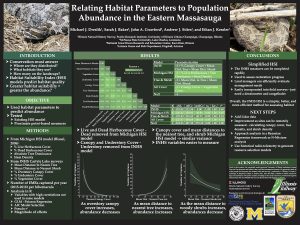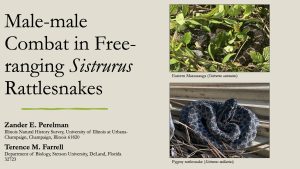Dr. Dreslik, Rose Arnold, Emily Asche, Andrea Colton, and Izabelle Jaquet presented at the Emydine Conservation Symposium at Juniata College in Huntingdon, Pennsylvania July 10th-12th, 2023.
Conservation Guidance, Status, Prioritization, and Implementation for the Recovery of the Spotted Turtle, Clemmys gutatta, in Illinois
Michael J. Dreslik*,
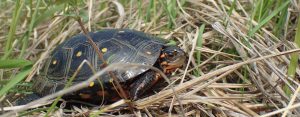 The Spotted Turtle (Clemmys gutatta) has always been a rare species in Illinois and was once thought extirpated. Its historical distribution likely encompassed the former interdunal wetlands along Lake Michigan, now occupied by the greater Chicago metropolitan region. Few populations remained on the landscape post- settlement, and only two remain extant, with one exhibiting severe decline. As such, the Spotted Turtle is protected as an endangered species. The Illinois Department of Natural Resources has instituted a new framework for species conservation consisting of three primary works, a Species Guidance Document, Status Assessment, and Conservation Implementation Plan. In addition to this effort, an Amphibian and Reptile Conservation Strategy was developed using expert solicitation to prioritize conservation actions and delineate threats. Using the information available, I will briefly cover where we are with the recovery of the Spotted Turtle in Illinois.
The Spotted Turtle (Clemmys gutatta) has always been a rare species in Illinois and was once thought extirpated. Its historical distribution likely encompassed the former interdunal wetlands along Lake Michigan, now occupied by the greater Chicago metropolitan region. Few populations remained on the landscape post- settlement, and only two remain extant, with one exhibiting severe decline. As such, the Spotted Turtle is protected as an endangered species. The Illinois Department of Natural Resources has instituted a new framework for species conservation consisting of three primary works, a Species Guidance Document, Status Assessment, and Conservation Implementation Plan. In addition to this effort, an Amphibian and Reptile Conservation Strategy was developed using expert solicitation to prioritize conservation actions and delineate threats. Using the information available, I will briefly cover where we are with the recovery of the Spotted Turtle in Illinois.
Population Structure of Three Isolated Northern Illinois Blanding’s Turtle (Emydoidea blandingii) Populations
Rose A. Arnold*, Emily A. Asche, Michael J. Dreslik,
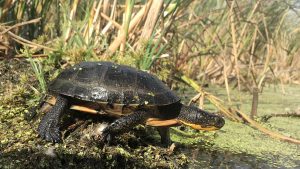 The Blanding’s Turtle (Emydoidea blandingii) is declining range-wide due to synergistic threats associated with habitat fragmentation, loss, and degradation. In Northern Illinois, Blanding’s Turtle populations are often isolated in an urbanized landscape with little chance for interpopulation migration. Thus, it is imperative to monitor populations inhabiting isolated patches because of risks from demographic and environmental stochasticity due to small population dynamics. By collecting data on sex, stage, and morphometrics on all captured individuals, our study will determine if concerning patterns or biases in the size, sex, or stage structure exist in three northeastern Illinois populations. For example, biased sex ratios toward adult males could indicate decreased adult female abundance and impact population growth through depressed recruitment rates. Additionally, a skewed stage structure toward juveniles could indicate decreased adult abundance from unusually low adult survivorship. Our results could aid regional wildlife managers by signaling potential threats to the demography of small, isolated populations.
The Blanding’s Turtle (Emydoidea blandingii) is declining range-wide due to synergistic threats associated with habitat fragmentation, loss, and degradation. In Northern Illinois, Blanding’s Turtle populations are often isolated in an urbanized landscape with little chance for interpopulation migration. Thus, it is imperative to monitor populations inhabiting isolated patches because of risks from demographic and environmental stochasticity due to small population dynamics. By collecting data on sex, stage, and morphometrics on all captured individuals, our study will determine if concerning patterns or biases in the size, sex, or stage structure exist in three northeastern Illinois populations. For example, biased sex ratios toward adult males could indicate decreased adult female abundance and impact population growth through depressed recruitment rates. Additionally, a skewed stage structure toward juveniles could indicate decreased adult abundance from unusually low adult survivorship. Our results could aid regional wildlife managers by signaling potential threats to the demography of small, isolated populations.
Reducing the Risk of Prescribed Burns on Ornate Box Turtles (Terrapene Ornata) in Illinois
Izabelle S. Jaquet*, Devin A. Edmonds, Andrea L. Colton, Ethan J. Kessler, Michael J. Dreslik
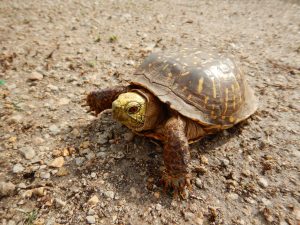 Native prairie ecosystems and associated herpetofauna have significantly declined throughout the 21st century. Once common throughout Midwest prairies and grasslands, the Ornate Box Turtle (Terrapene ornata) is of conservation concern in multiple states, including Illinois. Notable threats to population persistence include road mortality, illegal harvesting, and increased predation from mesopredators. Unfortunately, prescribed burns present an additional threat. While necessary, there is an increased risk of harming Ornate Box Turtles if burns are conducted between spring emergence and the beginning of winter dormancy. The loss of even a few individuals can drastically reduce population viability. To better understand the timing of dormancy, we used radiotelemetry to monitor 26 Ornate Box Turtles across three Illinois sites. We also collected shell and soil temperatures with data loggers to determine when and under what conditions turtles are at risk from burns. By combining radiotelemetry observations with shell temperature data, we determined when turtles were above ground. We then created a model predicting emergence based on environmental variables, such as air temperature, precipitation, and time of year. The best model to predict above ground activity considered the interaction of day of year and current air temperature. Our results can aid land managers and ecologists in determining the best time to conduct prescribed burns in Ornate Box Turtle habitat.
Native prairie ecosystems and associated herpetofauna have significantly declined throughout the 21st century. Once common throughout Midwest prairies and grasslands, the Ornate Box Turtle (Terrapene ornata) is of conservation concern in multiple states, including Illinois. Notable threats to population persistence include road mortality, illegal harvesting, and increased predation from mesopredators. Unfortunately, prescribed burns present an additional threat. While necessary, there is an increased risk of harming Ornate Box Turtles if burns are conducted between spring emergence and the beginning of winter dormancy. The loss of even a few individuals can drastically reduce population viability. To better understand the timing of dormancy, we used radiotelemetry to monitor 26 Ornate Box Turtles across three Illinois sites. We also collected shell and soil temperatures with data loggers to determine when and under what conditions turtles are at risk from burns. By combining radiotelemetry observations with shell temperature data, we determined when turtles were above ground. We then created a model predicting emergence based on environmental variables, such as air temperature, precipitation, and time of year. The best model to predict above ground activity considered the interaction of day of year and current air temperature. Our results can aid land managers and ecologists in determining the best time to conduct prescribed burns in Ornate Box Turtle habitat.
Baseline Energetic Requirements of Ornate Box Turtles (Terrapene ornata)
Andrea L. Colton*, Michael J. Dreslik,
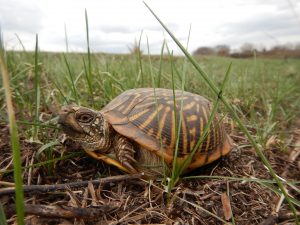 Increasing ambient temperatures due to climate change may lead to altered behaviors as turtles attempt to regulate internal body temperatures. Increased efforts to maintain temperatures may result in energetic tradeoffs, leading to reduced individual fitness and, thus, population abundance. Estimation of resting metabolic rates for turtles affords calculation of baseline energetic requirements and the potential to predict costs associated with warming landscapes. Using flow-through respirometry, we will determine the resting metabolic rates (RMRs) of adult Ornate Box Turtles (Terrapene ornata) across a temperature gradient to provide information on energetic costs. The baseline estimates will then be used to determine the annual RMR costs on the landscape.
Increasing ambient temperatures due to climate change may lead to altered behaviors as turtles attempt to regulate internal body temperatures. Increased efforts to maintain temperatures may result in energetic tradeoffs, leading to reduced individual fitness and, thus, population abundance. Estimation of resting metabolic rates for turtles affords calculation of baseline energetic requirements and the potential to predict costs associated with warming landscapes. Using flow-through respirometry, we will determine the resting metabolic rates (RMRs) of adult Ornate Box Turtles (Terrapene ornata) across a temperature gradient to provide information on energetic costs. The baseline estimates will then be used to determine the annual RMR costs on the landscape.
Population Structure of the Western Pond Turtle (Actinemys spp.) Across Twelve Military Installations in California
Emily Asche*, Matthew I. Parry, Thomas S. B. Akre, Robert Lovich, Michael J. Dreslik
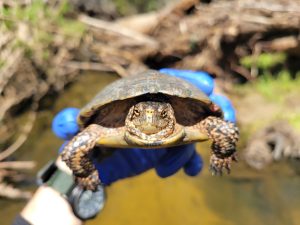 Western Pond Turtle (Actinemys spp.) populations are currently threatened with habitat loss, predation, and shell disease. The synergies among threats have caused severe population declines whereby they are an endangered species in Washington, a sensitive species in Oregon, and a species of special concern in California. It is imperative to investigate their status in California to determine how prevalent threats are and what level of conservation action needs to be taken to avoid declines. We examined the population structure of the Western Pond Turtle populations at twelve military installations across California through sampling in one-week bouts using 50 aquatic traps at one visit per base. We recorded the body size, life stage, and sex of all individuals. Our study is intended to represent a first pass at determining if there are any immediate conservation concerns, such as biases in stage or sex ratios and population size structure.
Western Pond Turtle (Actinemys spp.) populations are currently threatened with habitat loss, predation, and shell disease. The synergies among threats have caused severe population declines whereby they are an endangered species in Washington, a sensitive species in Oregon, and a species of special concern in California. It is imperative to investigate their status in California to determine how prevalent threats are and what level of conservation action needs to be taken to avoid declines. We examined the population structure of the Western Pond Turtle populations at twelve military installations across California through sampling in one-week bouts using 50 aquatic traps at one visit per base. We recorded the body size, life stage, and sex of all individuals. Our study is intended to represent a first pass at determining if there are any immediate conservation concerns, such as biases in stage or sex ratios and population size structure.
